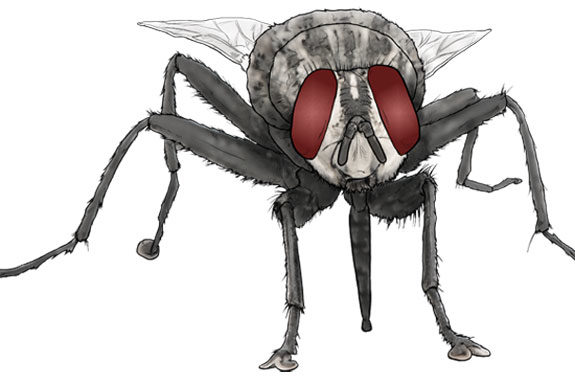We often wonder why some critters were put on the face of this earth, especially flies. In reality, the entire group of filth flies serves a very important purpose. The main “job” that flies perform, which is done by the larval (immature) stage, is to speed up the breakdown of decaying organic matter.
Almost as soon as animal feces, spilled feed, wet hay or any other suitable medium becomes available during the warmer months of the year, this group of flies immediately starts laying eggs on its surface. If the temperature is correct for fly development (optimum temperature 75°F to 85°F), reproduction continues with a complete generation (egg to egg laying adult) in as short as eight days.
There are many different species of flies that are considered to be “filth flies,” but the main two species we are concerned with as livestock producers are the stable fly (Stomoxys calcitrans) and the house fly (Musca domestica). The house fly is the most frequent problem during the warmer months, but the stable fly is probably the most costly due to possible production losses. There are several other species that can also be a problem, especially for graziers, and some that are actually beneficial to our fly control program.
In total fly management, a series of techniques are needed to combat the constant cycle of fly development. First, determine what species are present on a dairy and where those flies are breeding. Start by digging around to determine where the fly larvae (maggots) are developing.
Manure management is often viewed as the largest variable in a fly control program, but any decaying organic matter may be the major source of adult flies. The silage pit, spillage under overhead bins, torn silage bags, wet decaying spilled feed, hay bales, any of the feed commodities and even grass clippings can be the source of significant pest fly populations.
The stable fly will develop in decaying cow manure, but the main development source is often wet, decaying feed, hay and other commodities. A pile of grass clippings, hay, etc. will usually breed more flies than an equal or larger quantity of animal feces.
In most situations, 90 percent of a dairy’s flies will develop in less than 10 percent of the dairy. If you can identify that troublesome area and eliminate it, a fly control program will be well on its way to success. The program needs to be a decaying organic matter effort and not just manure management.
Overall proper sanitation may be the greatest, single factor, but all aspects of the program will need to be addressed to provide an economical but yet effective method of keeping fly issues to a minimum. The use of parasitic wasps is one tool in the arsenal, as well as the appropriate use of pesticides, traps, sticky tapes, propane burners, waste and lagoon management, etc.
Although fly control is often assigned to someone with very little authority on the dairy, it needs to be a “high priority” issue and receive attention equal to the expensive problem that exists. University research done by Dr. John Campbell at the University of Nebraska has shown that a moderate population of stable flies may result in production losses in excess of 10 to 15 percent. Other factors influence the drop in production, including heat stress from fly avoidance.
House fly populations don’t directly impact milk production but may indirectly be very costly to your operation. House flies have been shown to have the ability to transmit numerous diseases to both humans and livestock. Their presence may result in contaminated milk, sick animals, lawsuits from neighbors, irritated employees and poor marital relations.
In the past, most producers talked about “fly control,” but in today’s environment we need to use fly management techniques, which often may be more economical than the “old way” of depending totally on chemicals – often supplied by a pest control operator – to keep fly populations suppressed. If producers can educate and properly train dairy employees (and themselves), fly control should be less expensive, more environmentally friendly, done with an existing labor force and without substantial additional cost.
Fly management requires the support of the entire dairy staff and cannot be achieved with “fire-fighting techniques.” It requires a concerted effort to implement the various parts of the program. It is very important that breeding sites are eliminated and not allowed to re-develop. Unless employees understand the need and have a grasp of what is necessary, it is extremely difficult to keep an effective program in operation. A training program for you and your employees is very important to establish a basis for an effective fly management program. PD
Additional fly control training materials are available at www.spalding-labs.com in both English and Spanish from the Spalding Labs website.
Editor’s note: This is the first in a series of articles that will explore how to minimize pest flies in the most cost- effective manner and also address the training of effective fly control for employees.

-
Bill Clymer
- Senior Scientist
- Spalding Laboratories
- Email Bill Clymer






